Brainstorming is one of the fastest ways to generate new ideas, but without structure those ideas can get lost. Mind mapping software gives teams a visual way to capture, organize, and connect thoughts so they become actionable plans instead of forgotten notes. These tools make it easier to collaborate in real time, see relationships between concepts, and link creativity directly to execution.
In this article, you’ll learn what to look for in a mind mapping platform and get an overview of 18 leading tools. Each one is designed to help teams stay aligned, move quickly from concept to project, and keep momentum long after the initial brainstorming session ends.
Try monday work managementWhat is mind mapping software?
Mind mapping software provides a digital space to capture ideas and organize them around a central theme. Teams use it to structure thoughts, connect related concepts, and turn brainstorms into clear strategies.
Unlike a whiteboard, a digital mind map can grow and adapt. Everyone can contribute at the same time, see updates instantly, and link ideas to tasks that move work forward.
The result is one shared picture of priorities. Teams gain clarity on complex projects and make decisions faster with less back-and-forth.
How to choose a mind mapping tool
The best tool makes brainstorming simple and keeps teams aligned. Focus on how easy it is to use, how well it supports collaboration, and whether it can grow with your team.
- Ease of use and visual options: A tool should feel intuitive from the start. Look for simple drag-and-drop functionality and clear visuals that keep attention on the ideas, not the software.
- Collaboration and sharing: Teams need to add input, comment, and see changes in real time. Built-in collaboration keeps everyone aligned and ensures feedback happens in one place.
- Pricing and scalability: Choose software that works for today’s needs but can also support a larger team. A scalable option avoids the cost and disruption of switching platforms later.
18 best mind mapping software tools for getting creative
The right software helps teams consolidate ideas, see connections, and move from brainstorming to clear action.
Today’s tools are more than diagrams. They are collaborative spaces where teams can share ideas, refine them together, and connect outcomes to real work.
We’ve reviewed 18 leading options that support collaboration, integrate with project workflows, and help teams go from concept to completion.
1. monday work management
monday work management helps teams move from brainstorming to execution in one platform. While the product doesn’t include a built-in mind mapping tool, it connects with marketplace apps so teams can brainstorm visually and link ideas directly to projects.
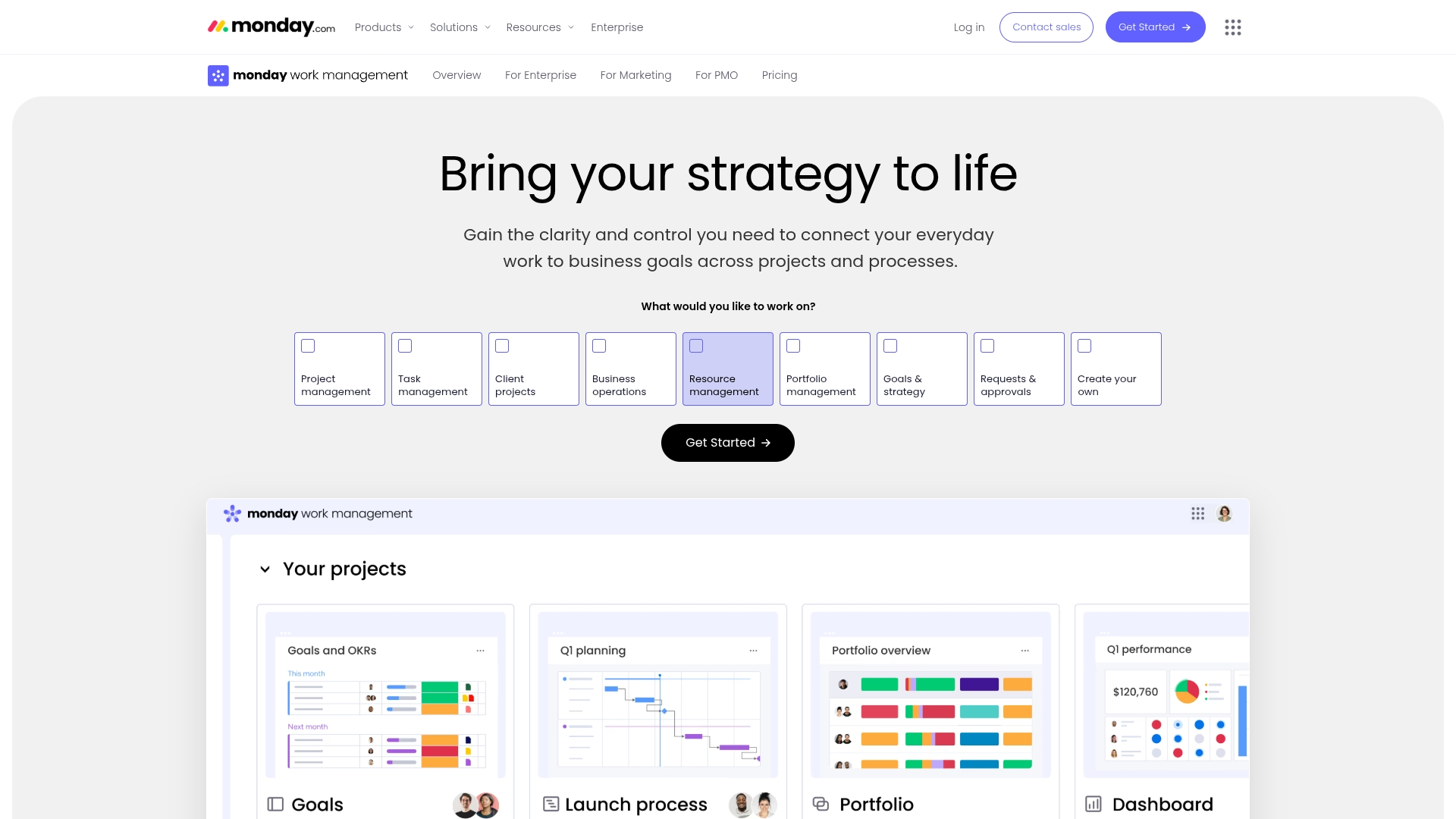
Best for: Turning brainstormed ideas into trackable tasks within a broader workflow.
Key features:
- Connect third-party mind mapping apps to your project boards for a smooth transition from idea to task.
- Collaborate in real-time on project boards where ideas from your mind map become actionable items.
- Keep visual brainstorming and project planning connected in one central platform to ensure no great ideas get lost.
Pricing:
- Free: $0 forever for up to 2 seats with 3 boards and basic features.
- Basic: $9/seat/month (billed annually) with unlimited items and 5GB storage.
- Standard: $12/seat/month (billed annually) with timeline views and 250 automations.
- Pro: $19/seat/month (billed annually) with advanced features and 25,000 automations.
- Enterprise: Custom pricing with enterprise-scale features and 250,000 automations.
- Annual billing saves 18% compared to monthly billing.
- Nonprofit discounts available.
- Note: Mind mapping functionality is available via third-party apps in the monday.com marketplace, which may require a separate subscription or have different plan limitations.
Why it stands out:
- Acts as a central work hub that integrates with brainstorming tools, keeping everything in one unified workspace.
- Allows teams to transform ideas from an integrated mind map into actionable work items with assignees, deadlines, and status tracking.
- Provides enterprise-grade collaboration and project management features that scale with your team.
monday work management includes AI capabilities that help teams work faster across the platform. The assistant can create tasks, summarize long updates, and build formulas to speed up planning. These capabilities make it easier to move from brainstorming into a structured project plan.
The platform offers more than 200 pre-built automation recipes to reduce manual work. Teams can automatically assign owners, move items between groups based on status, and send notifications to keep everyone updated. Available actions scale by plan, with enterprise accounts supporting up to 250,000 per month.
monday work management connects with over 200 tools such as Slack, Google Drive, and Microsoft Teams. These integrations centralize files and communication, ensuring brainstormed ideas stay linked to the tasks that come from them. An API is also available for teams that need custom connections.
Mind mapping apps in the marketplace can be connected directly to boards. This lets teams capture ideas visually, then turn them into tasks with owners and deadlines. The result is a connected workflow where brainstorming and execution happen in one place.
2. Miro
Through its collaborative whiteboard platform, Miro redefines how teams brainstorm and organize ideas with powerful mind mapping capabilities. The platform specializes in real-time visual collaboration, making it an excellent choice for remote teams who need to capture, structure, and expand on complex ideas together.
Best for: Distributed teams that need a collaborative whiteboard for real-time brainstorming and mind mapping.
Key features:
- AI-powered mind mapping: Automatically generate new branches and discover related topics to expand your ideas in seconds.
- Infinite canvas: Enjoy unlimited space with simple drag-and-drop functionality to build and customize your mind maps without limits.
- Real-time collaboration: Work together seamlessly with features like live cursors, commenting, tagging, and presentation mode.
- Extensive template library: Kickstart your projects with over 300 pre-built templates and use auto-layout to keep your maps organized.
- Talktrack and integrations: Record interactive video walkthroughs of your mind maps and connect Miro to your favorite work tools.
Pricing:
- Free: $0 forever for unlimited members, with 3 editable boards and 10 Miro AI credits per team per month.
- Starter: $8 per member/month (billed annually) or $10 billed monthly. Includes unlimited boards and 25 Miro AI credits per member per month.
- Business: $16 per member/month (billed annually) or $20 billed monthly. Includes multiple workspaces and 50 Miro AI credits per member per month.
- Enterprise: Custom pricing. Includes advanced features and 100 Miro AI credits per member per month.
Miro also offers free plans for educational institutions and discounted pricing for eligible nonprofits.
Considerations:
- Performance can slow down with very large, complex mind maps during real-time collaboration.
- Mobile app functionality is limited compared to the desktop and web versions.
3. Xmind
Xmind provides a comprehensive suite of mind mapping and brainstorming tools designed to transform how teams visualize and organize complex ideas. The platform’s strength lies in its ability to combine multiple diagram structures within a single workspace, making it perfect for everything from personal brainstorming sessions to academic research and strategic planning.
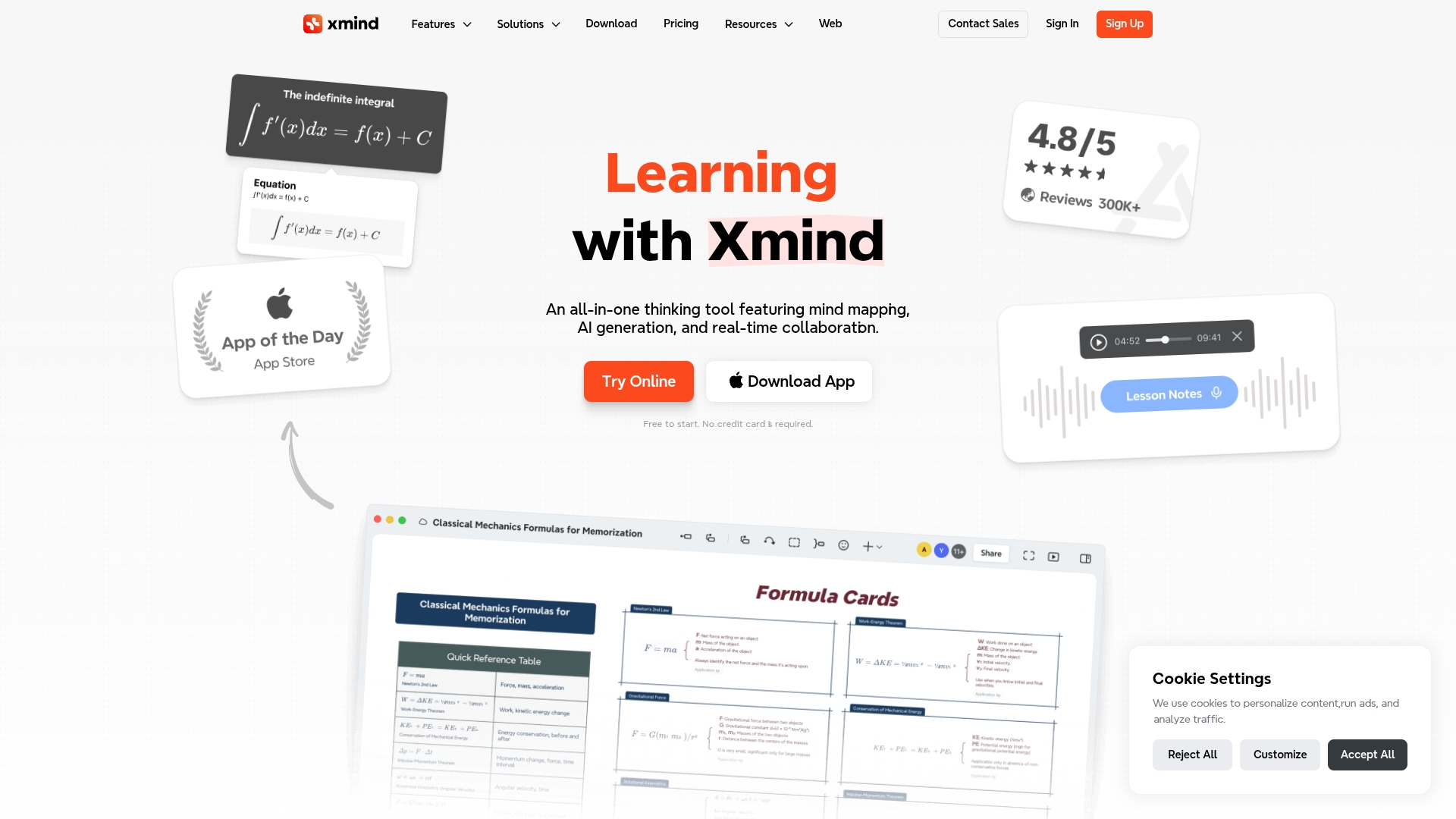
Best for: Individuals and teams who want flexible diagram types like fishbone charts, timelines, and org charts in one workspace.
Key features:
- Multiple structure support including mind maps, fishbone diagrams, timelines, and org charts that can be mixed within single projects
- AI-powered features for generating mind maps, creating to-do lists, and summarizing content automatically
- Pitch Mode transforms mind maps into professional slideshow presentations with ZEN Mode for distraction-free focused work
Pricing:
- Free: $0 (10 AI credits, 3-day version history, unlimited topics and maps)
- Pro: $4.92/month (unlimited slides, colored branches, attachments, custom themes)
- Premium: $8.25/month (500 AI credits monthly, 30-day version history, unlimited storage)
- Up to 50% discount available for yearly subscriptions
- Special pricing for non-profits, government organizations, and educational institutions
Considerations:
- Free version has export limitations and lacks advanced collaboration features that require paid subscriptions
- Some users report the newer versions feel less feature-rich compared to the legacy XMind 8 Pro, particularly missing certain advanced project management capabilities like Gantt charts
4. MindMeister
Focused on real-time collaboration and seamless task management, MindMeister is an online mind mapping tool that changes how teams brainstorm and organize ideas. Its specialization in live collaboration and direct integration with workflow management makes it ideal for distributed teams needing to visualize complex projects and convert ideas into action.
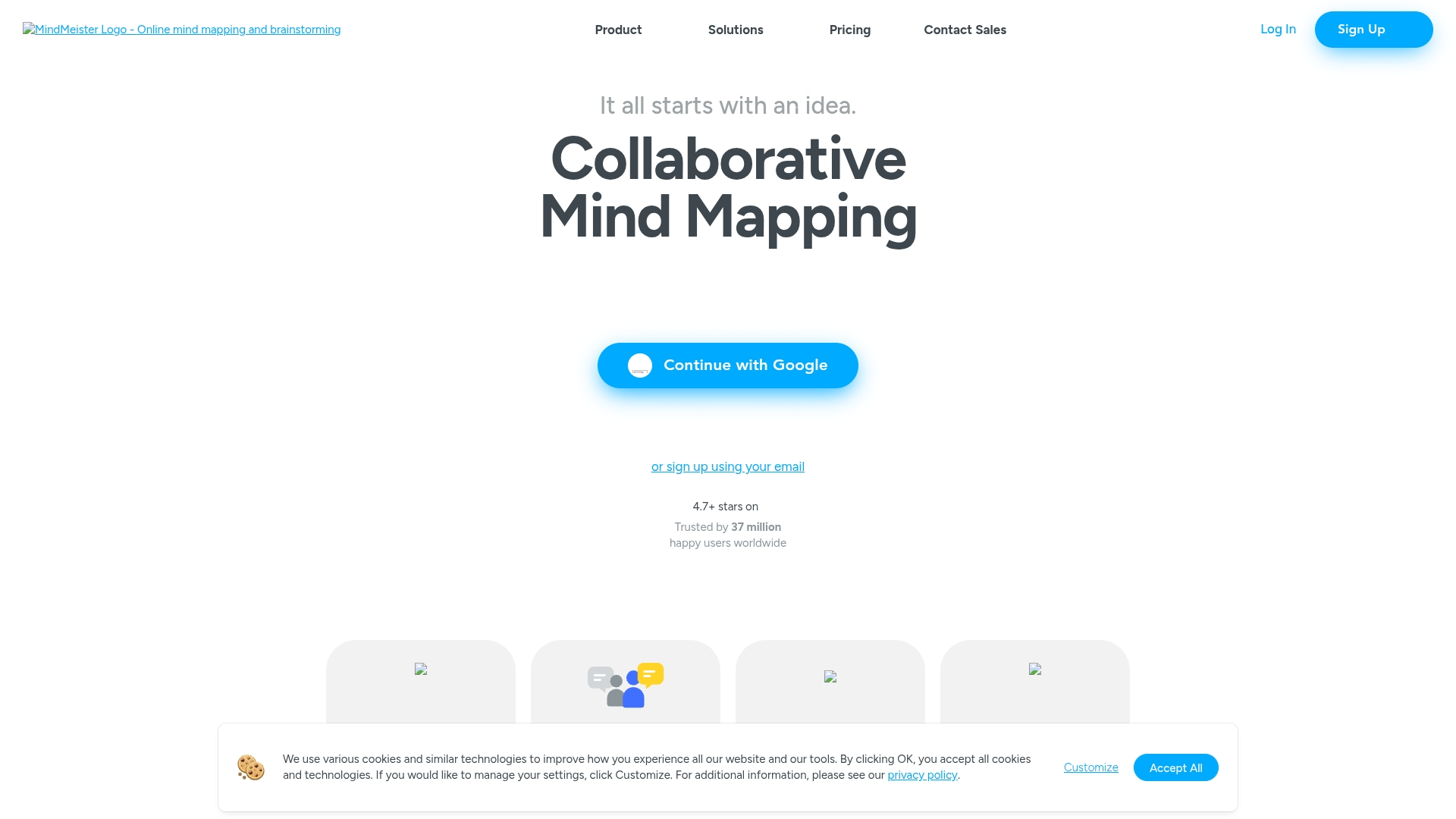
Best for: Teams that need live collaboration and seamless task management tied to brainstorming sessions.
Key features:
- Real-time collaborative editing with comments, voting, and integrated chat for seamless team brainstorming
- Direct integration with MeisterTask to transform mind map ideas into actionable project tasks
- Presentation mode that converts mind maps into dynamic slideshows for stakeholder meetings
Pricing:
- Free: $0/month (3 mind maps, unlimited collaborators)
- Personal: $6.50/user/month (unlimited mind maps, file exports, private maps)
- Pro: $10.50/user/month (unlimited attachments, custom branding, Google Workspace integration)
- Business: $15.50/user/month (group sharing, SAML SSO, dedicated Customer Success Manager)
- Yearly and 6-month subscriptions save up to 22%
- Education and NGO discounts available
Considerations:
- Free version limits users to only three mind maps and lacks export functionality
- Some users report concerns about subscription renewal policies and customer service responsiveness
5. Canva
With its design-first approach, Canva turns mind mapping into a visually stunning experience for brainstorming and idea organization. The platform combines its signature drag-and-drop interface with extensive customization options, making it perfect for teams who want their mind maps to look as polished as their final presentations.
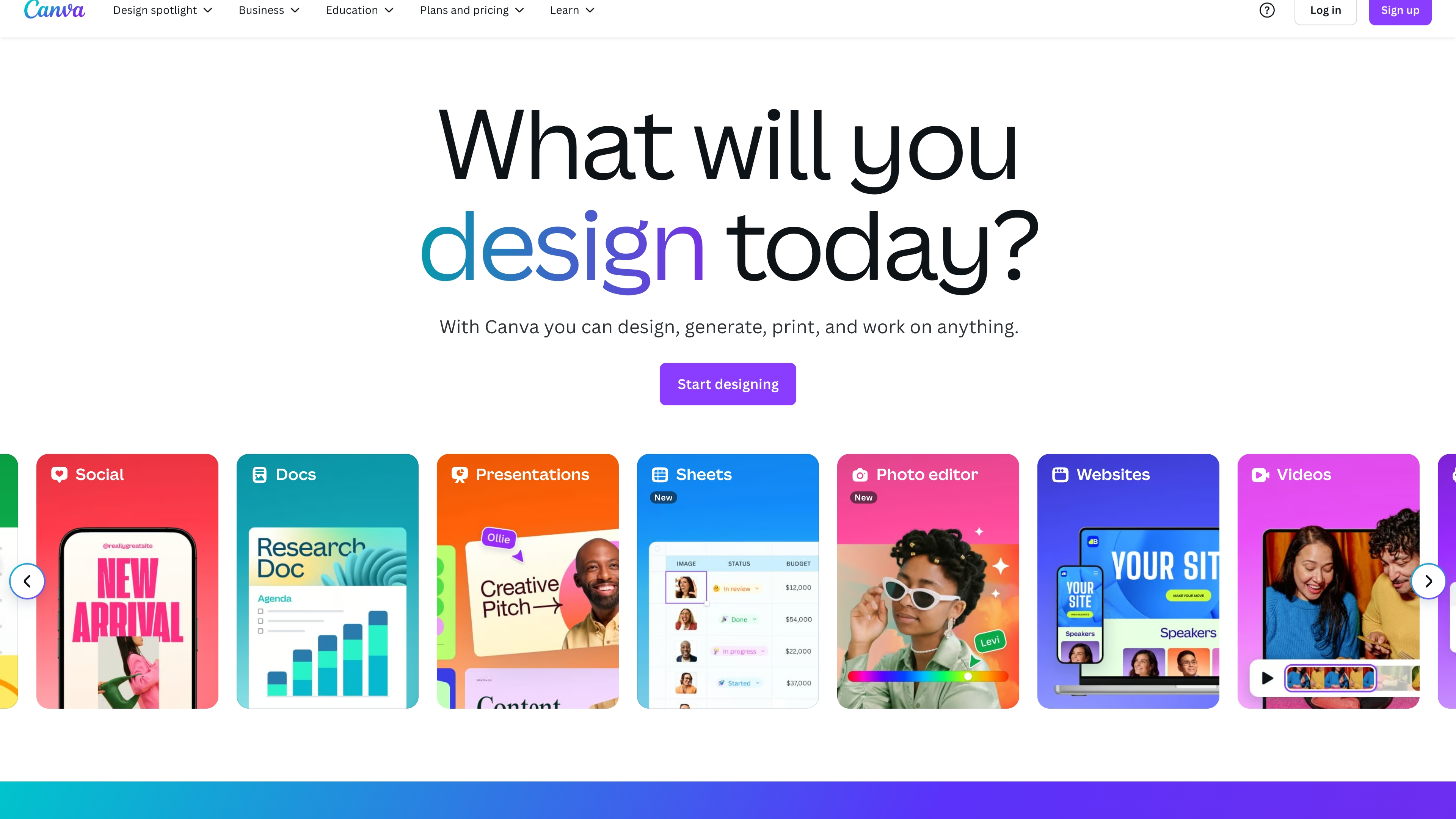
Best for: Teams that want visually polished mind maps with access to a large design and media library.
Key features:
- Extensive template library with professionally designed mind map layouts for various industries and use cases
- Real-time collaboration with built-in commenting, timer features, and team editing capabilities
- Access to Canva’s vast media library including icons, illustrations, photos, and custom graphics for visual enhancement
Pricing:
- Canva Free: $0/year for one person
- Canva Pro: $120/year for one person with unlimited premium templates and 1TB storage
- Canva Teams: $100/year per person (minimum 3 people, $300/year total)
- Canva Enterprise: Contact sales for custom pricing
- Nonprofits receive free Canva Teams subscription for up to 50 users
- K-12 educational organizations get premium features at no cost
Considerations:
- Limited advanced mind mapping features compared to dedicated brainstorming software like Miro or specialized mind map tools
- Canvas size restrictions may feel limiting for extensive brainstorming sessions that require infinite workspace expansion
6. Lucidchart
Lucidchart brings clarity to complex ideas through a comprehensive diagramming platform that includes robust mind mapping capabilities. This cloud-based solution excels at real-time collaboration and seamless integration with popular productivity suites, making it perfect for teams who need to brainstorm, plan, and execute projects together.
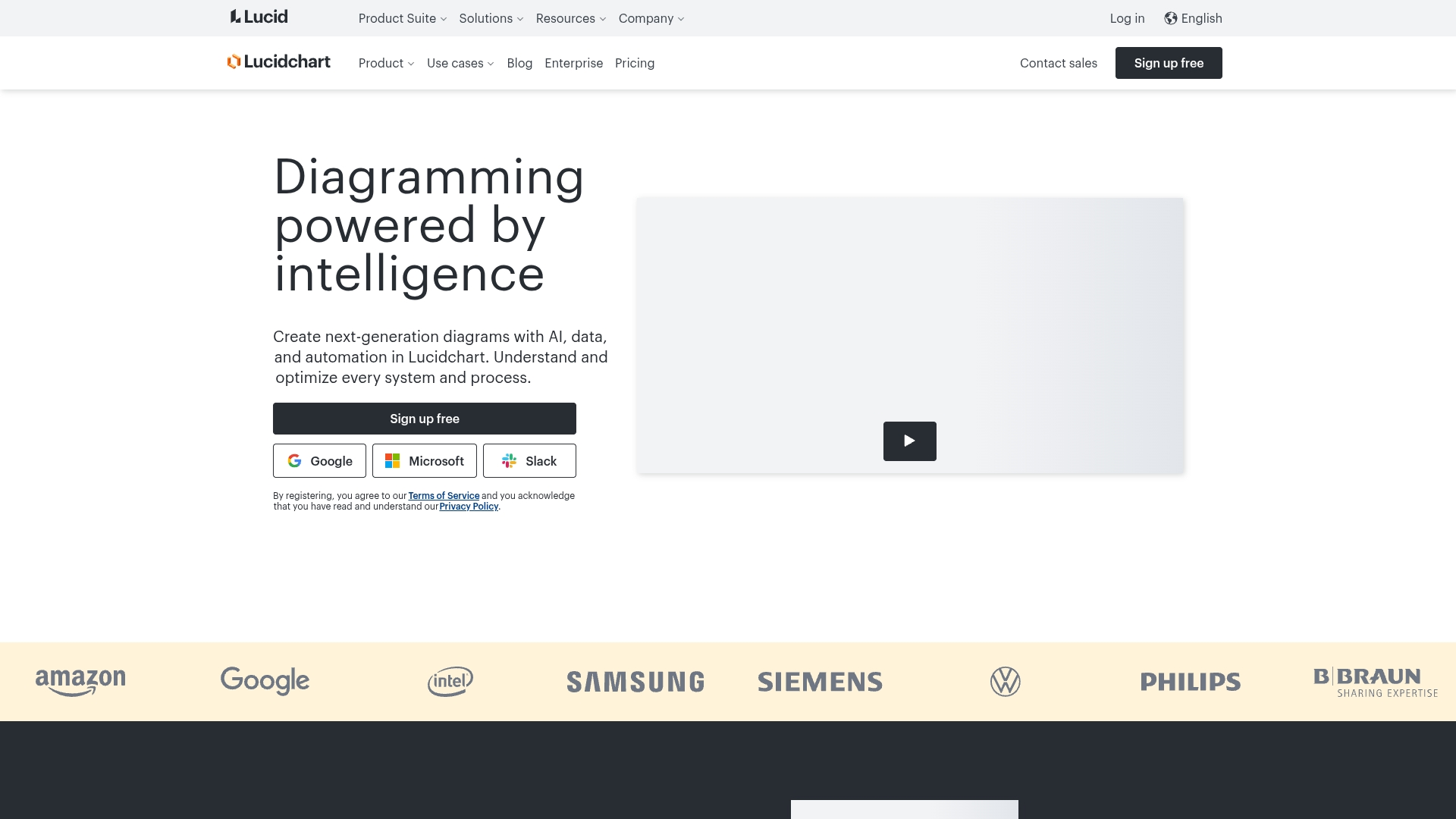
Best for: Organizations that need mind mapping integrated with professional diagramming and documentation.
Key features:
- AI-powered idea generation and summarization to enhance brainstorming sessions
- Real-time collaboration with unlimited team members across any device or browser
- Extensive import/export capabilities supporting multiple formats including Visio, PDF, and text files
Pricing:
- Free: $0 (3 editable documents, 60 shapes per document)
- Individual: $9/month (unlimited documents and objects, premium templates)
- Team: $10/user per month (advanced collaboration features, integrations)
- Enterprise: Custom pricing (includes advanced security and admin controls)
Considerations:
- Recent interface updates have removed some manual customization options that power users previously enjoyed
- Mind mapping features may feel less comprehensive compared to dedicated mind mapping software like XMind or MindMeister
7. Ayoa
Bridging the gap between ideation and execution, Ayoa functions as a comprehensive visual workspace that elevates mind mapping from a simple brainstorming exercise. This all-in-one platform combines Tony Buzan’s original mind mapping methodology with modern AI-powered features and seamless task management integration. Built with creative teams and neurodivergent professionals in mind, Ayoa offers unique radial maps and organic branch styles that stimulate natural thinking patterns.
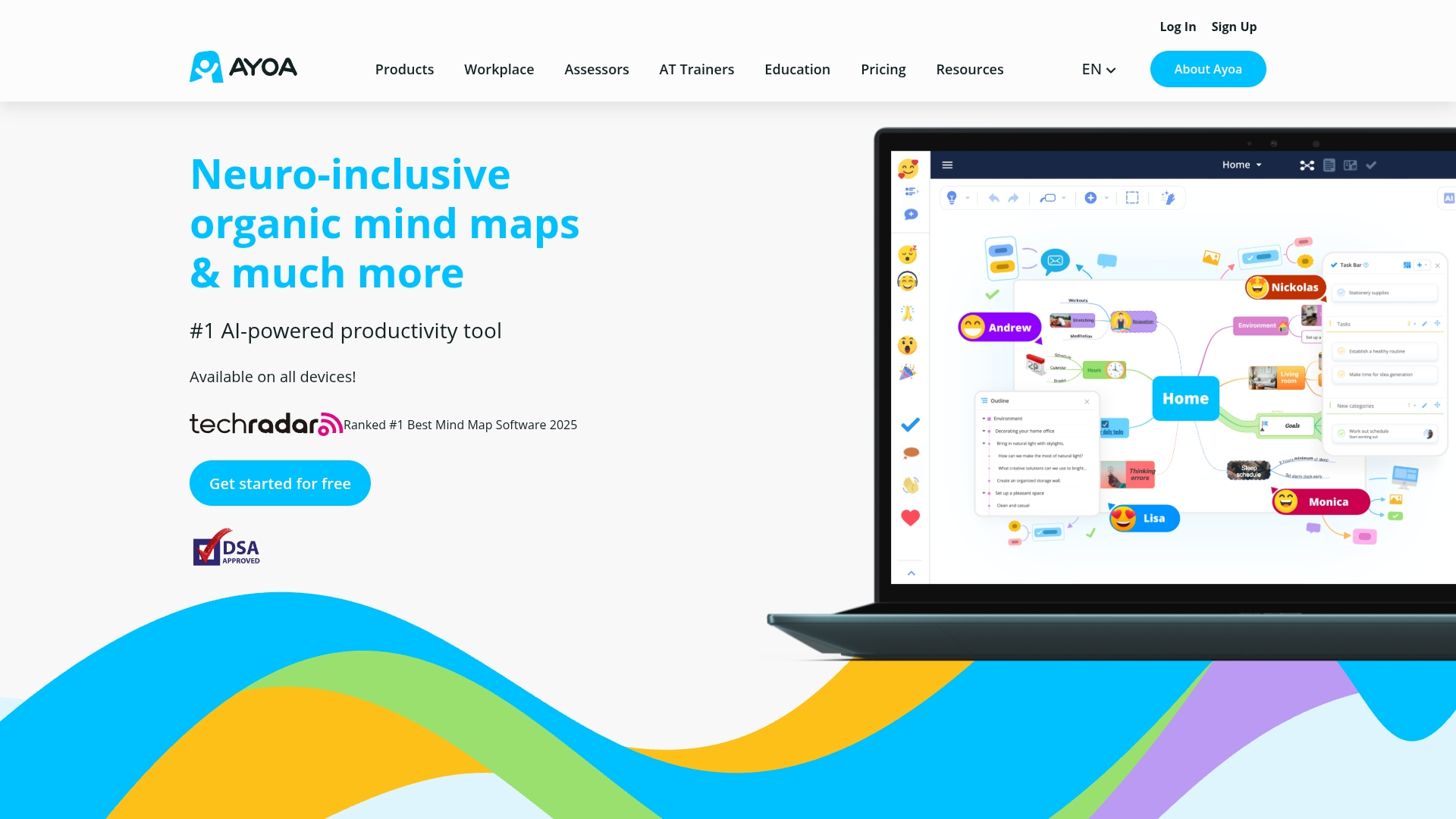
Best for: Creative professionals and neurodivergent users who benefit from flexible, organic map styles and task conversion.
Key features:
- Multiple mind map styles (organic, speed, radial) and freehand drawing capabilities
- AI-powered idea generation and map creation from simple prompts or uploaded documents
- Direct conversion of mind map branches into tasks on visual project boards and Gantt charts
- Unique features like ‘maps in maps’ for embedding maps within each other and focus modes designed for neurodivergent users
Pricing:
- Free plan: Up to 10 mind maps. After the trial, features like whiteboards and task boards become view-only.
- Ultimate plan: £10/user/month (billed annually) or £13/user/month (billed monthly) for unlimited maps and full features. Prices don’t include local taxes, and discounts may be available for 2-year billing.
- 7-day free trial available for the Ultimate plan.
- Educational discounts available.
Considerations:
- Performance can slow down when working with large, complex mind maps.
- The mobile app has limited functionality compared to the desktop and web versions.
8. Coggle
For teams seeking simplicity, Coggle offers a straightforward, browser-based mind mapping tool that gets teams brainstorming and organizing ideas without the complexity. The platform specializes in real-time collaboration and unlimited image uploads, making it perfect for educators, students, and small teams who need to visualize concepts quickly.
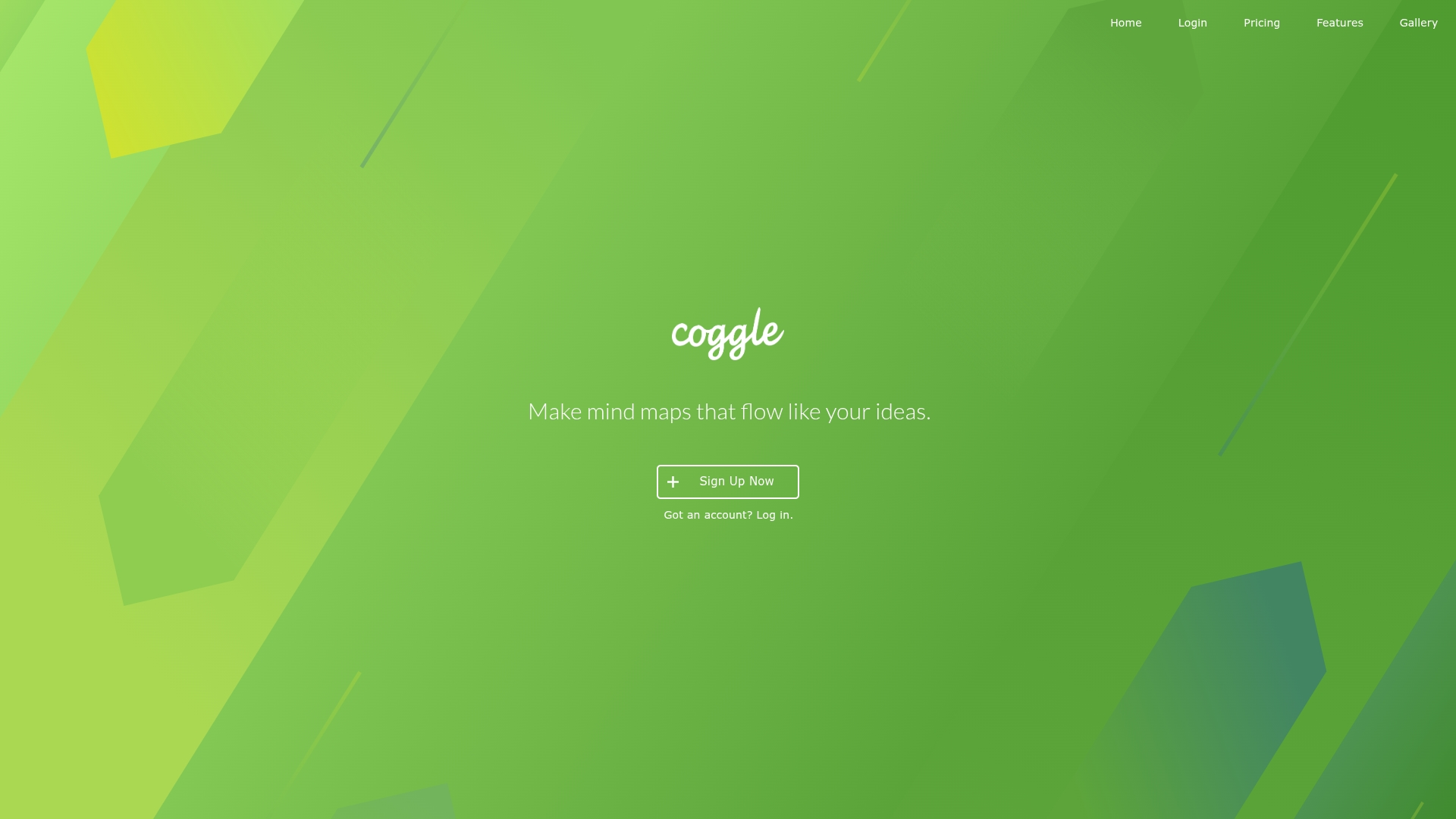
Best for: Educators, students, and small teams looking for a simple, browser-based tool to create mind maps quickly.
Key features:
- Real-time collaboration with instant updates visible to all team members
- Unlimited image uploads with drag-and-drop functionality
- Complete change history with the ability to revert to previous versions
Pricing:
- Free Forever: $0 (3 private diagrams, unlimited public diagrams)
- Awesome: $5/month (unlimited private diagrams, advanced shapes, collaboration by link)
- Organisation: $8/member/month (SAML SSO, branded diagrams, user management)
Considerations:
- Free plan limits users to only three private diagrams, which may not be sufficient for professional use
- Limited customization options for fonts, colors, and visual styling compared to more advanced mind mapping tools
9. ClickUp
Within its all-in-one platform, ClickUp converts complex project workflows into visual mind maps that connect directly to actionable tasks. It specializes in bridging the gap between brainstorming and execution, making it ideal for teams who want to turn ideas into a workflow app without switching between multiple tools.
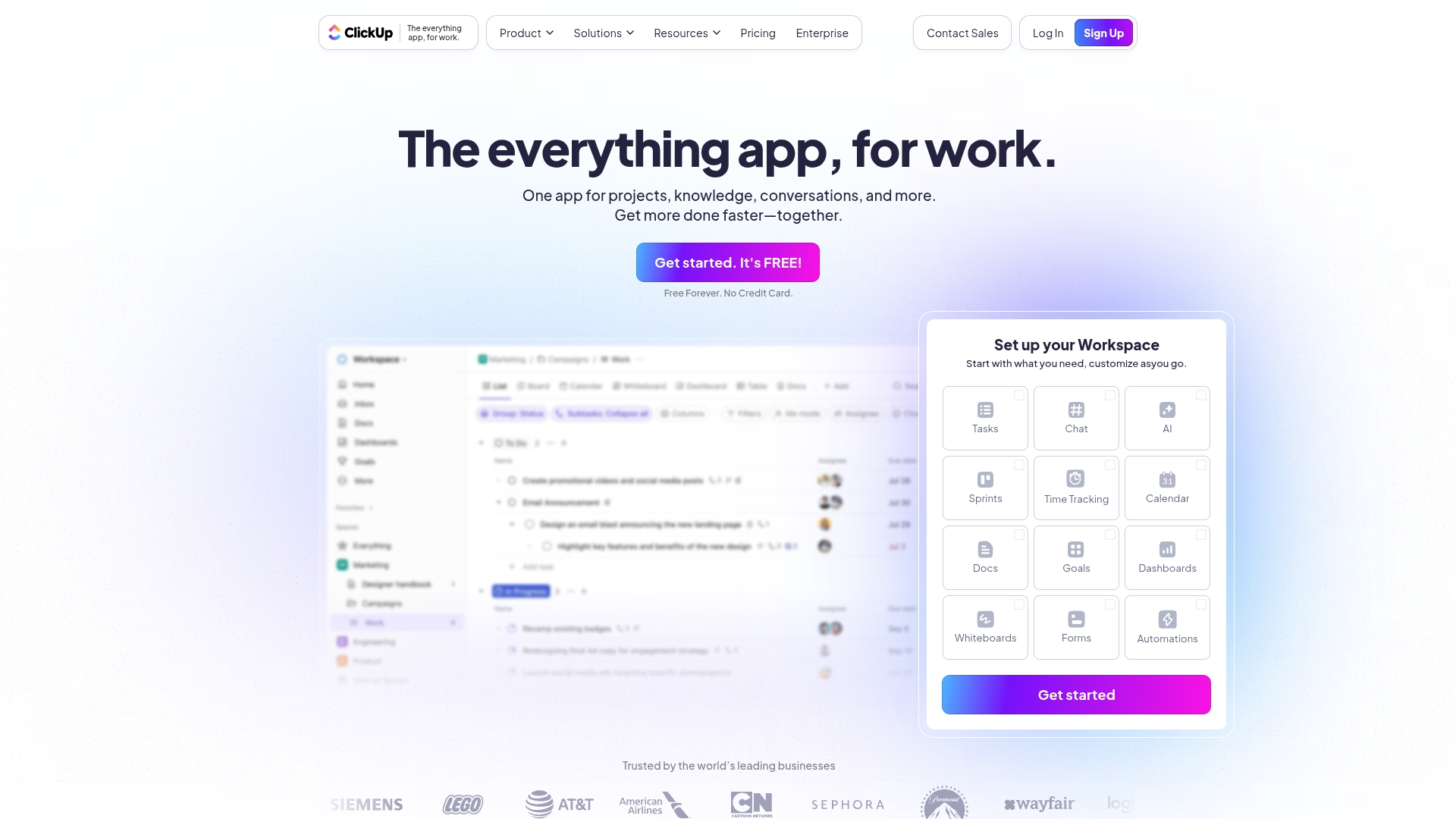
Best for: Teams that want to turn brainstorms directly into tasks inside their project management workflow.
Key features:
- Task integration that converts mind map nodes directly into actionable ClickUp tasks
- Automatic re-layout functionality that maintains project hierarchy as plans evolve
- Dual mind mapping options with dedicated Mind Map view and flexible Whiteboards for different brainstorming needs
Pricing:
- Free Forever: $0 (includes basic mind mapping with 100-use limit)
- Unlimited: $7/user/month (includes unlimited storage and integrations)
- Business: $12/user/month (includes unlimited mind maps and advanced features)
- Enterprise: Custom pricing (includes white labeling and advanced security)
Considerations:
- Mind mapping features may not be as visually advanced as dedicated mind mapping tools like Miro or XMind
- Free and lower-tier plans have a cumulative 100-use limit for mind maps that doesn’t reset
10. Trello
Trello brings a visual approach to project management with its intuitive Kanban project management boards and card system. The platform’s strength is its simplicity and flexibility, making it perfect for teams who want to add mind mapping capabilities without leaving their familiar project management environment.
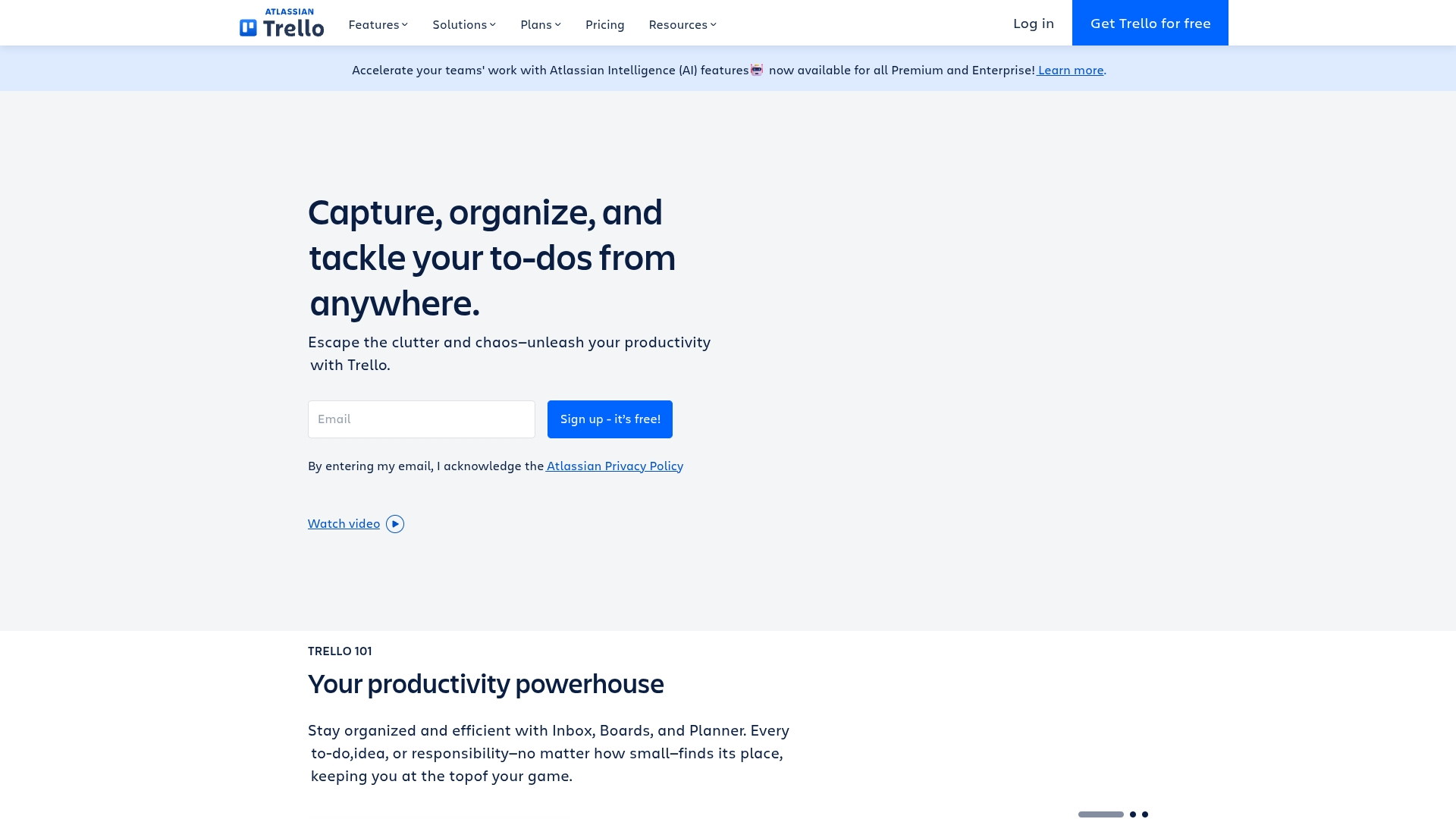
Best for: Teams that already use Trello boards and want mind mapping through add-ons without leaving their workspace.
Key features:
- Mind Map & Flow Chart Power-Up allows users to visualize Trello cards on a two-dimensional canvas with drag-and-drop functionality
- Integration with dedicated mind mapping tools like MindMeister for advanced brainstorming capabilities
- Unlimited canvas space for organizing complex processes and connecting related ideas through visual links
Pricing:
- Free: $0 for up to 10 collaborators per workspace with unlimited cards and up to 10 boards
- Standard: $5/user/month (billed annually) with unlimited boards and advanced features
- Premium: $10/user/month (billed annually) including AI features and additional views
- Enterprise: $17.50/user/month (billed annually) with advanced security and admin features
- Mind Map Power-Up requires separate subscription: $2-6/month depending on billing frequency
Considerations:
- Mind mapping functionality relies on third-party Power-Ups rather than native features, which may limit advanced capabilities compared to dedicated mind mapping software
- The combined cost of Trello subscription plus premium Power-Ups can exceed the price of specialized mind mapping tools with built-in task management
11. Notion
By merging notes, databases, and wikis, Notion creates a uniquely flexible workspace for organizing information. The platform specializes in customizable building blocks that adapt to any workflow, making it ideal for teams who need both structure and creative freedom. With its unique approach to connecting ideas visually, Notion serves as a powerful foundation for mind mapping and knowledge management.
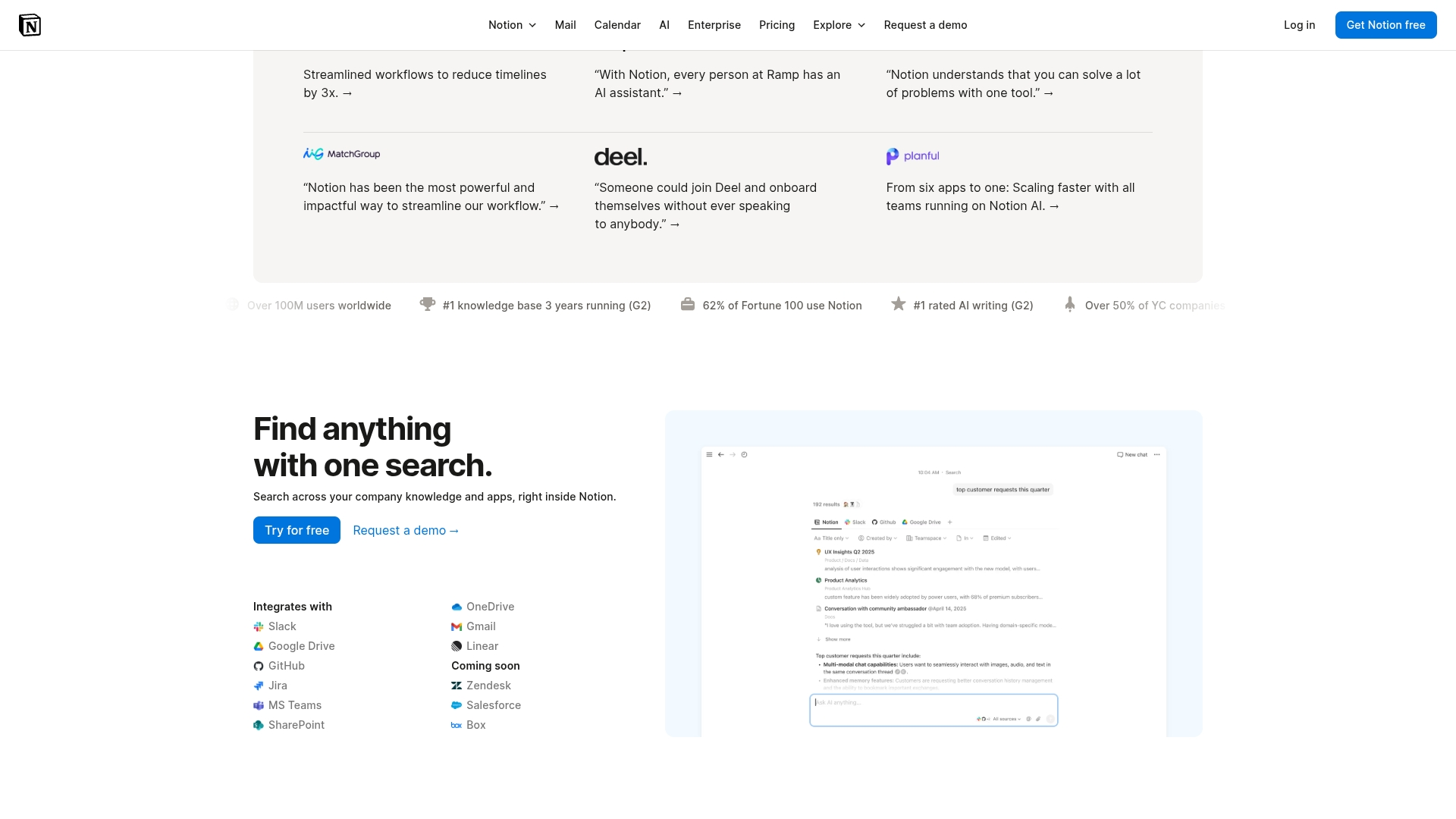
Best for: Teams that need flexible knowledge management with linked pages and optional mind map integrations.
Key features:
- Database and wiki integration that connects related concepts across your workspace
- Flexible page linking system that creates natural thought connections
- Third-party mind mapping integration through Mindmap.so for visual brainstorming
Pricing:
- Free: $0 per member/month (unlimited storage for individuals, limited trial for teams)
- Plus: $10 per member/month (unlimited collaborative blocks and file uploads)
- Business: $20 per member/month (includes SAML SSO and advanced features)
- Enterprise: Custom pricing (advanced security and compliance features)
Considerations:
- Mind mapping requires third-party integration rather than native functionality
- Learning curve can be steep for teams new to flexible workspace concepts
12. Smartsheet
Smartsheet elevates spreadsheet-style work management into a dynamic platform for business planning and workflow automation. The platform specializes in data-driven project management with robust process automation, making it ideal for teams who need structured processes and detailed reporting.
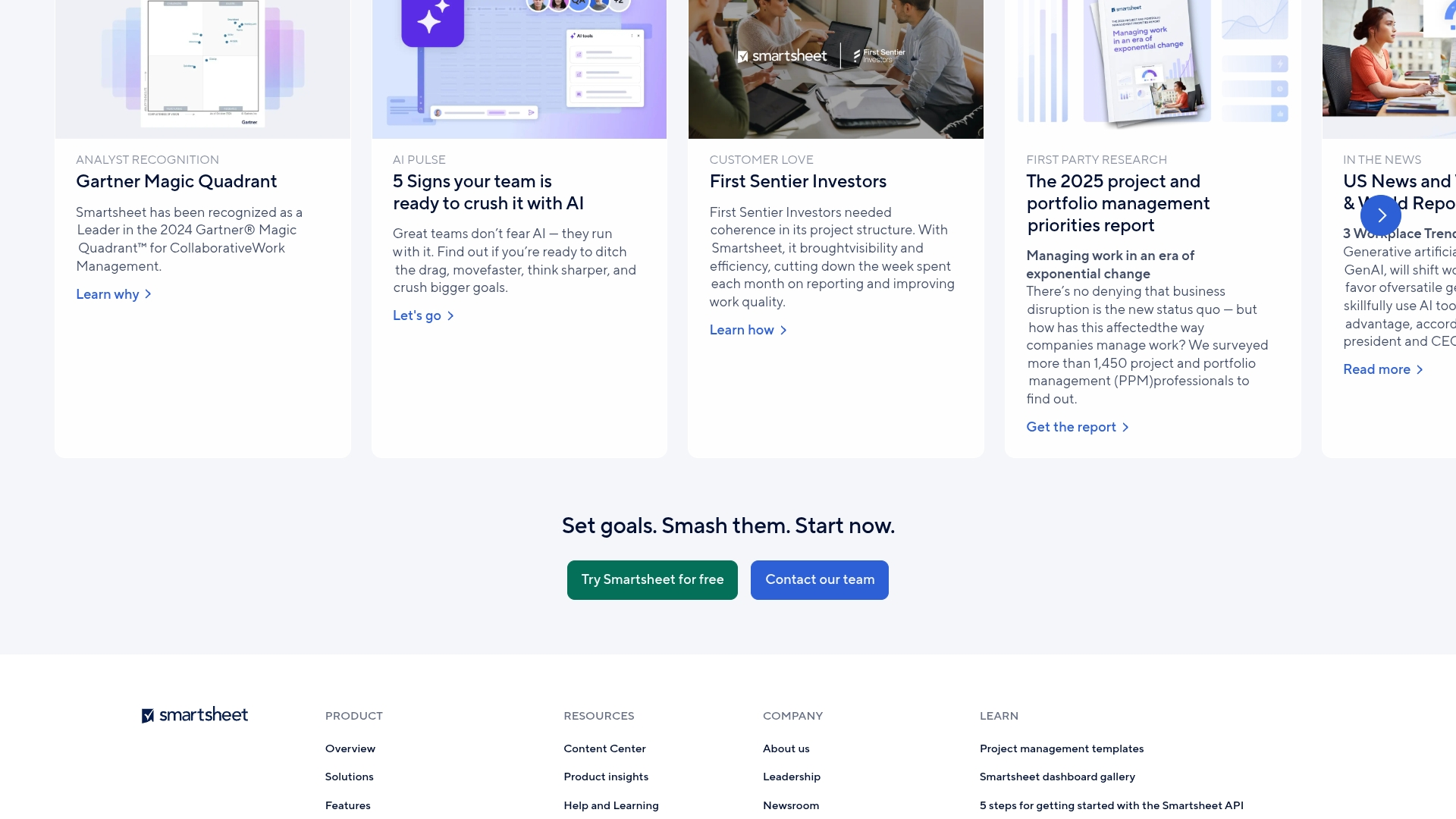
Best for: Teams that prefer spreadsheet-style work management and want to connect it with mind mapping templates or integrations.
Key features:
- Free mind map brainstorming templates for Microsoft Word for visual idea organization
- Connects with mind mapping tools like Miro and Lucidchart through manual setups, such as embedding or using third-party automation platforms
- Spreadsheet-like interface with powerful automation and reporting for managing brainstorming outcomes
Pricing:
- Pro: $129/member/month (billed monthly) for 1-10 members
- Business: $2419/member/month (billed monthly) for 3+ members
- Enterprise: Custom pricing
- Advanced Work Management: Custom pricing
Considerations:
- No native mind mapping feature requires reliance on external tools and integrations
- Setting up mind mapping workflows can be complex and may require additional software subscriptions
13. GitMind
GitMind leverages AI to convert text, documents, and raw ideas into visual diagrams in seconds. The platform specializes in intelligent automation and collaborative features, making it perfect for teams who want to streamline brainstorming and implement a knowledge management system. With its unique “AI Planet” community feature, users can tap into shared knowledge while building their own visual thinking processes.
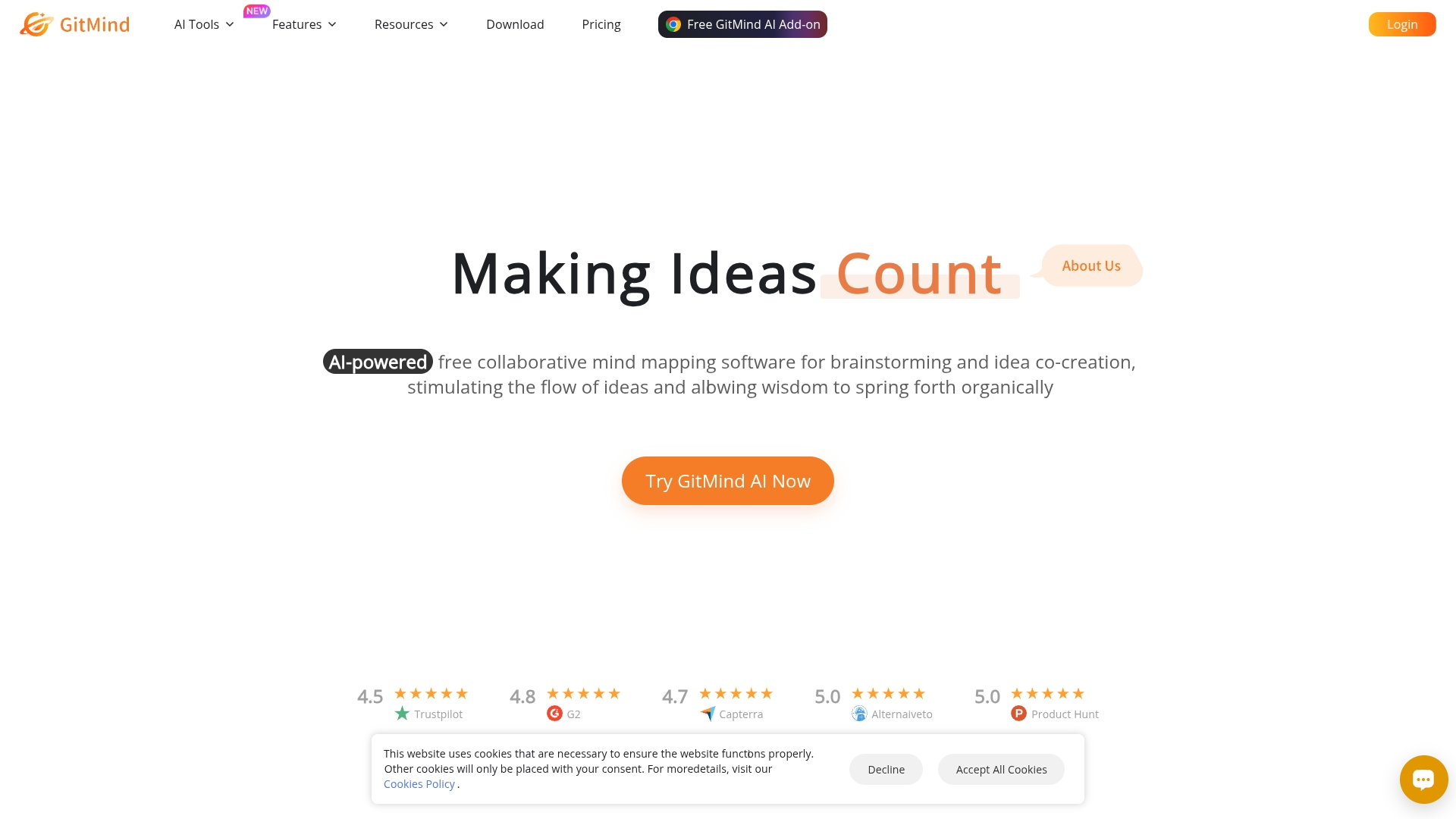
Best for: Teams and individuals who want AI-powered mind map generation and collaboration across devices.
Key features:
- AI-powered mind map generation from text, documents, webpages, and images through OCR technology
- Real-time collaborative editing with cross-platform synchronization across Windows, Mac, iOS, and Android
- Extensive template library with customizable themes, colors, and export options including PDF, PNG, and SVG formats
Pricing:
- Free: $0 (10 files, standard export, 30 images per map, 500 MB cloud storage)
- Basic: $4.08/month billed annually (unlimited files, HD export, 500 images per map, 10 GB storage)
- Pro: $5.75/month billed annually or $19/month (includes 2000 AI credits monthly, file summary up to 30MB)
- Ultra: $11.58/month billed annually or $39/month (5000 AI credits monthly, 50 GB storage, 800 images per map)
- Business: $170/month billed annually for 10 seats (50,000 AI credits monthly, dedicated support)
Considerations:
- The credit-based system for AI features can become expensive for heavy users and makes costs unpredictable
- Customer support response times can be slow, with some users experiencing delays with AI-controlled live chat
14. FigJam
FigJam’s intuitive digital whiteboard is engineered for real-time collaborative brainstorming and visual thinking. The platform seamlessly integrates with Figma’s design ecosystem, making it perfect for design teams and cross-functional collaborators who need to move from ideation to execution. With AI-powered features and over 300 templates, FigJam streamlines the creative process from initial concept to final design.
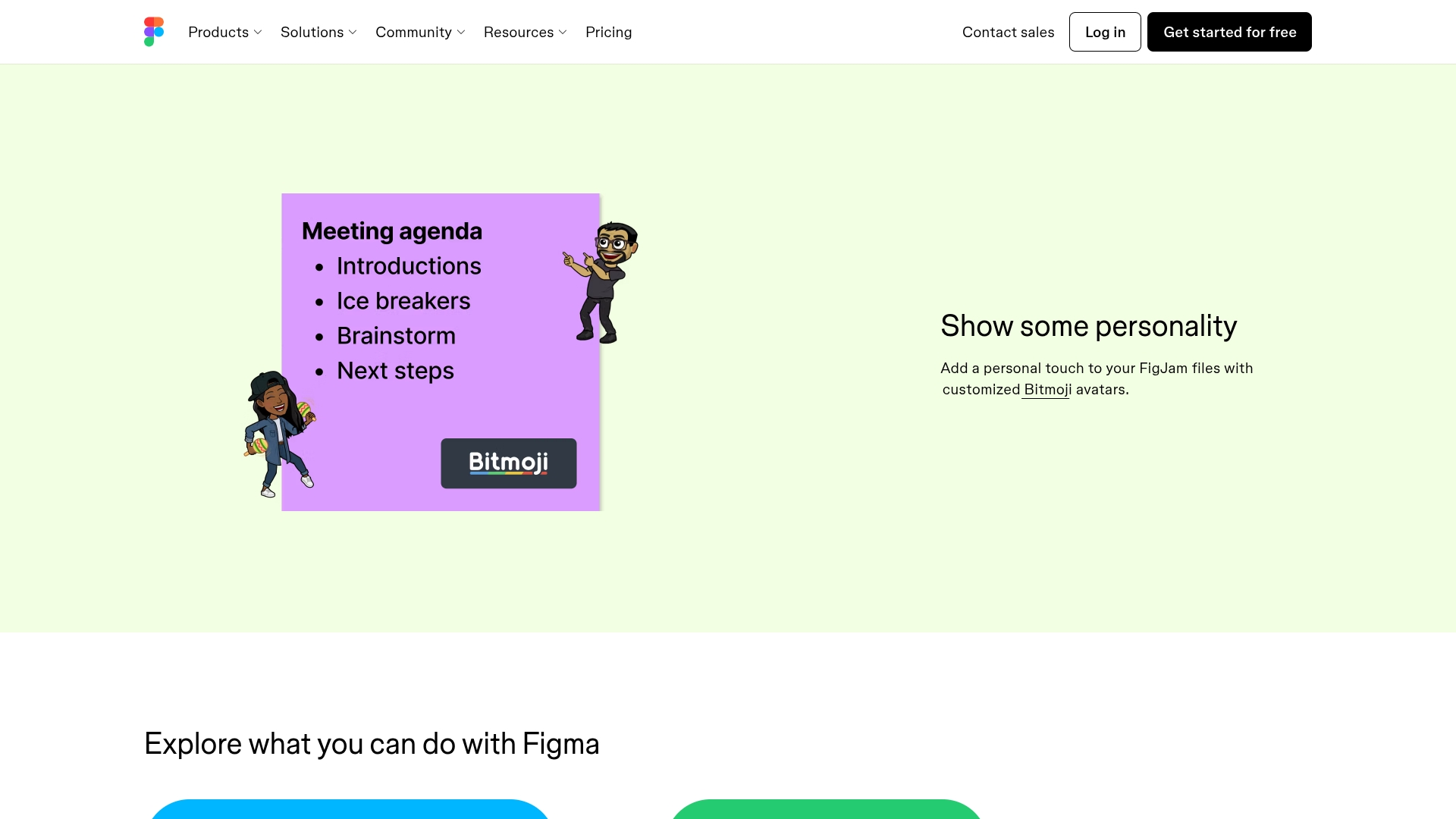
Best for: Design and cross-functional teams that brainstorm in Figma and want a whiteboard-style mind mapping option.
Key features:
- AI-powered mind map generator (Jambot) that creates structured maps from text prompts
- Real-time collaboration with cursor chat, stamps, and interactive brainstorming tools
- 300+ templates including mind maps, flow charts, and customer journey maps
Pricing:
- Starter: Free (limited features)
- Professional: $3-$16/seat/month (depending on seat type)
- Organization: $5-$55/seat/month (billed annually, depending on seat type)
- Enterprise: $5-$90/seat/month (billed annually, depending on seat type)
Considerations:
- Mind mapping features can feel shallow for complex, large-scale maps compared to dedicated mind mapping tools
- Limited ability to modify map structure after creation, such as changing directional flow from horizontal to vertical
15. Airtable
Airtable reimagines spreadsheet software as a powerful, visual database with collaborative capabilities. The platform bridges the gap between simple data entry and complex database management, making it accessible for teams who need structured data without technical complexity. While it doesn’t offer native mind mapping features, Airtable integrates seamlessly with dedicated mind mapping tools like Miro to visualize your organized data.
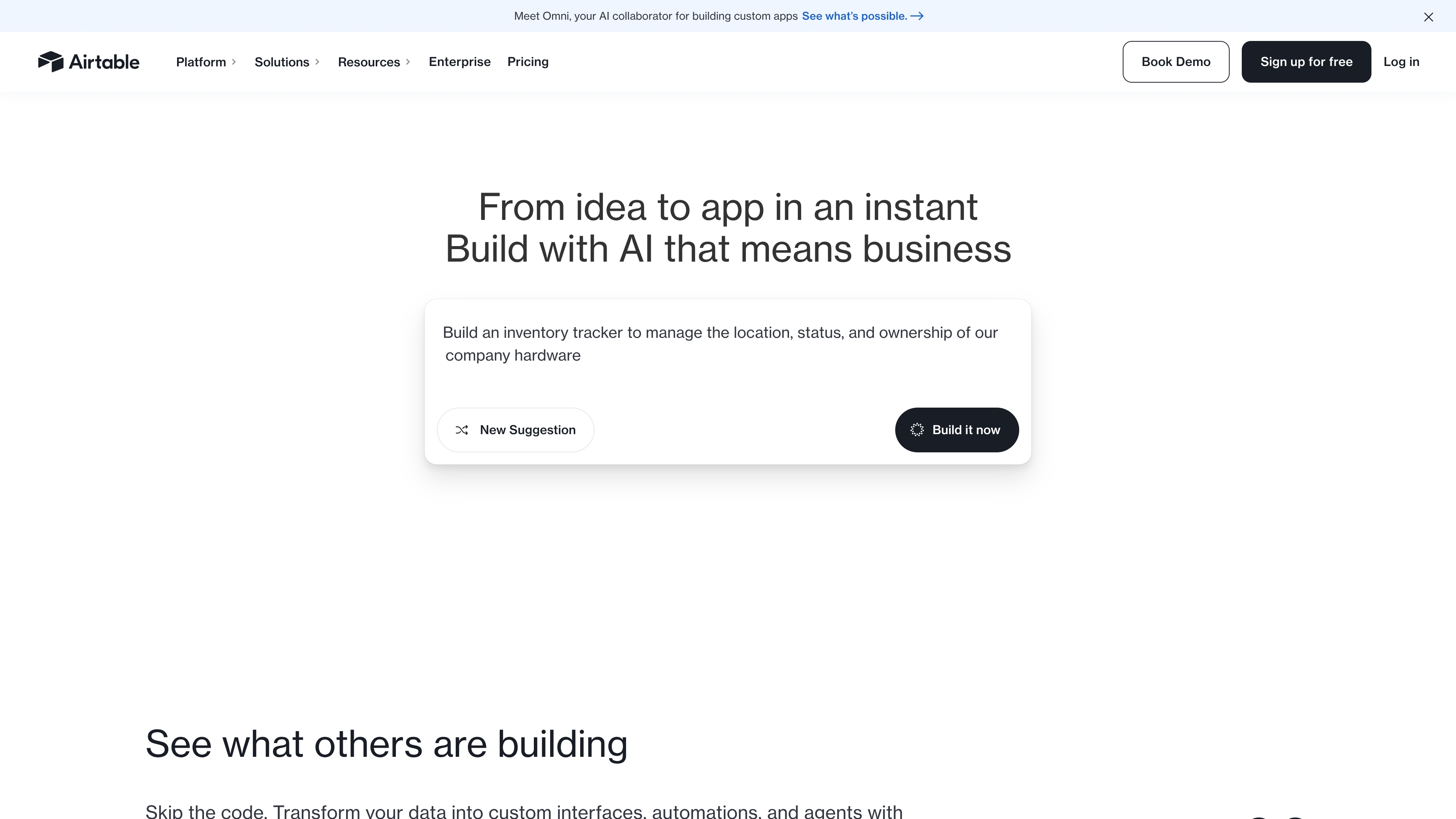
Best for: Teams that organize data in a relational database and connect it to mind mapping tools like Miro.
Key features:
- Relational database capabilities that connect data across multiple tables and projects
- Integration with Miro for mind mapping visualization of your structured data
- Customizable views including grid, calendar, and gallery formats for different workflow needs
Pricing:
- Free: $0/month for individuals with 1,000 records per base and basic features
- Team: $20/month per user (billed annually) with 50,000 records and unlimited editors
- Business: $45/month per user (billed annually) including advanced features and admin controls
- Enterprise Scale: Custom pricing for large organizations with enhanced security and governance
Considerations:
- Requires third-party integration for mind mapping functionality, adding complexity and potential additional costs
- Learning curve can be steep for users unfamiliar with database concepts and relational data structures
16. Mindomo
Mindomo offers a robust mind mapping software that merges visual thinking with powerful collaborative features. The platform specializes in real-time teamwork and educational applications, making it ideal for teachers, students, and business teams who need to brainstorm, plan projects, and organize complex information visually.
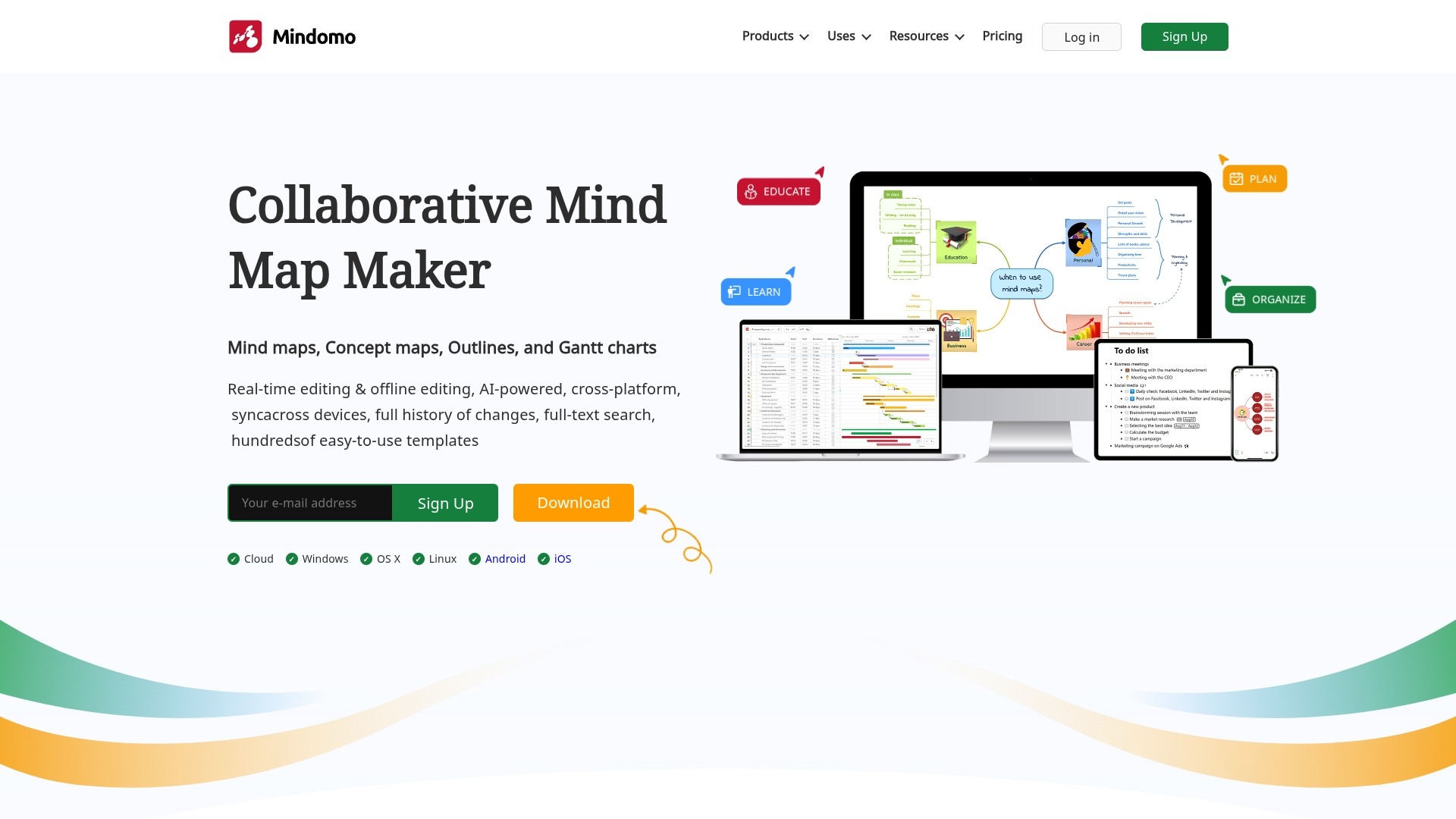
Best for: Educators and teams that need interactive mind maps with multimedia and real-time collaboration.
Key features:
- Real-time collaboration with live chat and comment features for team brainstorming sessions
- Multiple diagram types including mind maps, concept maps, Gantt chart software, and presentation modes
- Cross-platform synchronization with offline access across web, desktop, and mobile applications
Pricing:
- Free: €0/$0 per user/month with 3 diagrams and unlimited collaborators
- Premium: €6-€7/$7-$8.50 per user/month with unlimited diagrams and 50 AI credits monthly
- Professional: €13.50-€15/$16-$17.50 per user/month with guest editing and Gantt charts
- Manual subscription renewal required (not auto-renewed)
- 14-day money-back guarantee available
Considerations:
- Mobile interface can feel cramped with limited functionality compared to desktop versions
- Extensive feature set may overwhelm new users who prefer simpler mind mapping tools
17. EdrawMind
Powered by AI-driven automation, EdrawMind provides a comprehensive suite of mind mapping tools with extensive visual customization options. The platform targets students, educators, and business professionals who need versatile brainstorming and project planning capabilities across multiple devices and operating systems.
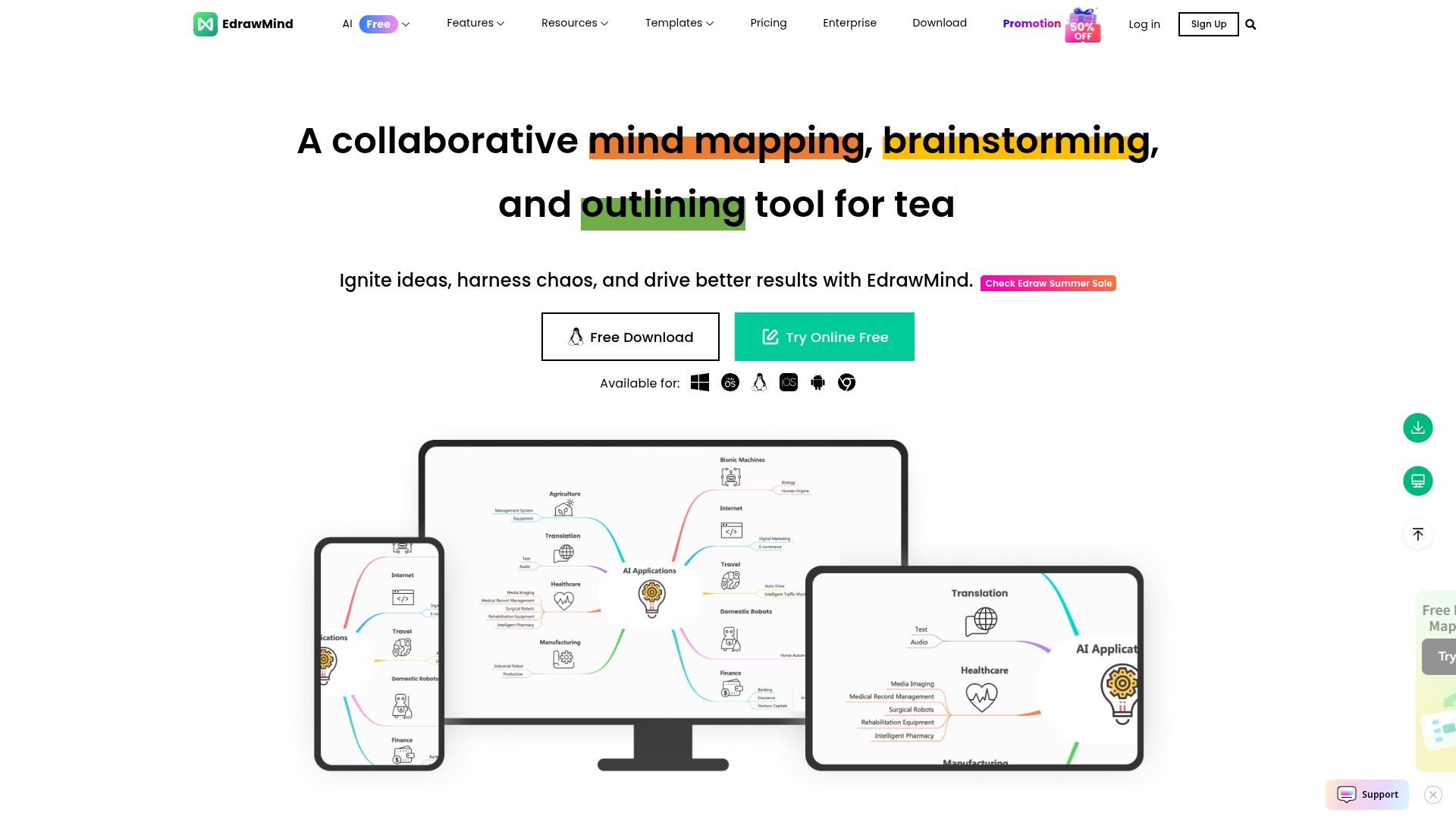
Best for: Students, educators, and professionals who need AI-assisted brainstorming and customizable layouts.
Key features:
- AI-powered mind map creation with one-click generation, SWOT analysis, and automated presentation building
- 22 diversified layouts with 33 themes and over 700 cliparts for visual customization
- Integrated Gantt chart mode for project management and timeline visualization within mind maps
Pricing:
- Free Plan: $0 (500 AI tokens, limited features, watermarked exports)
- Individual Plan: $4.90/month (billed annually) or $7.90/month (monthly billing)
- Team Plan: $6.90/user/month (billed annually) or $9.90/user/month (monthly billing)
- Enterprise Plan: Custom pricing (contact sales)
Considerations:
- Limited customization for topic positioning and spacing between elements
- Free version has significant restrictions on mind map quantity and advanced features
18. MindManager
MindManager is engineered to translate complex business information into dynamic visual maps that accelerate decision-making and keep projects on track. This professional mind mapping platform specializes in enterprise-grade project management and advanced data integration, making it ideal for large organizations managing complex workflows and strategic planning initiatives.
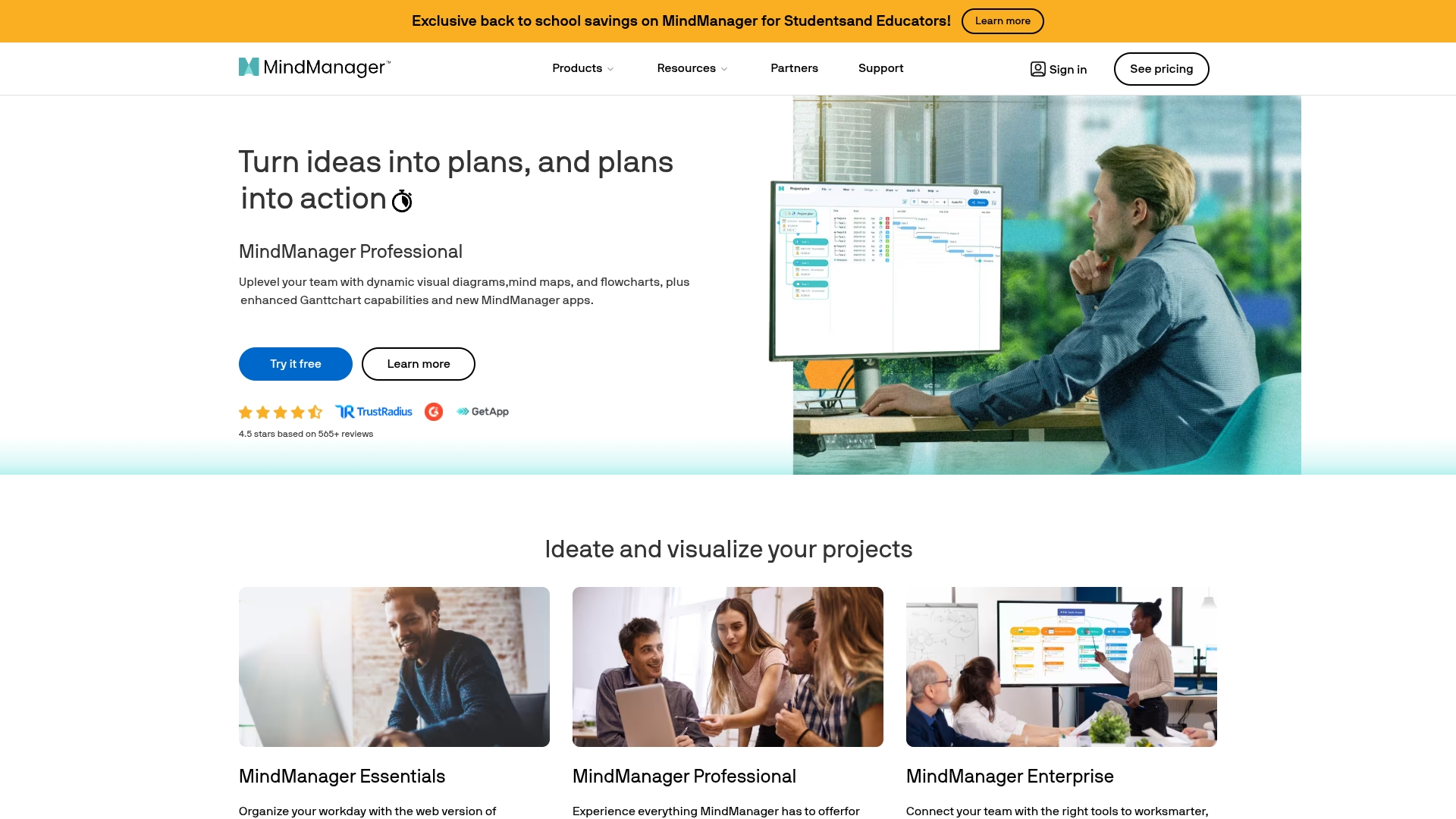
Best for: Enterprise teams managing complex projects that require advanced mapping, Gantt charts, and integrations with Microsoft tools.
Key features:
- Enhanced Gantt chart capabilities with project cost tracking and resource management
- Seamless integration with Microsoft Teams, SharePoint, Outlook, and other Office products
- Flexible mapping modes including hierarchical and non-hierarchical brainstorming options
Pricing:
- Essentials: $99/year (web version for individual projects)
- Professional: $179/year (complete experience with collaboration tools)
- One-time Purchase: $369 (perpetual desktop license)
- Enterprise: Custom pricing available for teams and organizations
- Students and Educators: Special pricing available
Considerations:
- Higher price point may be prohibitive for individual users or small businesses
- Extensive feature set can create a steep learning curve for new users
How to create a mind map step by step
A mind map helps turn scattered ideas into a clear, actionable plan. It’s a structured way for teams to see the big picture and agree on priorities.
Start with a single, clear goal in the center. Add main themes or phases branching out from that core idea to establish a shared starting point.
Add details using short keywords rather than full sentences. Use colors or icons to group related ideas, highlight priorities, and make the map easy to understand at a glance.
Review the map and draw connections between related items. Linking dependencies creates a visual roadmap that keeps the team aligned from kickoff through completion.
Tips for collaborative mind mapping in teams
Mind mapping works best when everyone can contribute to a shared structure. A facilitator can guide the process, keep discussion on track, and ensure each participant has a voice.
Visual organization helps prevent confusion. Color-coding, grouping similar ideas, or merging separate maps makes it easier to see the team’s full thinking in one place.
Different perspectives bring stronger outcomes. When ideas diverge, group them, compare pros and cons, or prioritize them together. Capture decisions and next steps directly on the map so the team leaves with clarity on what comes next.
Adapt the approach to the situation. Teams can use mind maps to set goals for a new quarter, break down complex projects, or share strategies across departments. The format makes collective knowledge easy to act on.
Where AI fits into mind mapping
AI can make brainstorming more effective by helping teams move from raw ideas to structured plans. Within monday work management, the AI assistant generates tasks, summarizes updates, and builds formulas that save time on setup.
Teams can use AI to capture ideas quickly, highlight priorities, and connect related items. These features reduce manual effort and make it easier to spot insights that guide decision-making.
With AI built into monday work management, brainstorms lead directly to clear project plans, so teams can focus on creativity while the platform handles the structure.
Level up your brainstorming with monday work management
Brainstorming sessions create valuable ideas, but those ideas lose impact if they aren’t captured in a system teams use every day. monday work management helps turn brainstorming into execution by connecting ideas directly to tasks, owners, and timelines.
Teams can capture input in a visual board, prioritize next steps, and assign responsibilities without switching tools. Automations and integrations keep everything updated so ideas move seamlessly into project workflows.
When brainstorming connects to planning and execution, teams gain a repeatable process that builds momentum and drives results.
FAQs
Which mind mapping software works best for enterprise collaboration?
Enterprise teams should look for software with strong security, user management, and integrations. monday work management is built to support large-scale collaboration and keep multiple teams aligned.
Can I use AI to generate mind maps automatically from text?
Yes. Many tools offer AI that converts text into a structured map, saving time and organizing ideas into a clear format.
How do mind mapping tools enhance remote team creativity?
Mind mapping tools give distributed teams a shared space to brainstorm in real time, making it easier to collect input, refine ideas, and stay aligned.
What's the difference between mind mapping and concept mapping software?
Mind maps branch from a single central idea, while concept maps connect multiple concepts in a more flexible structure.
How can I convert my mind maps into actionable project plans?
With a platform like monday work management, teams can turn mapped ideas into tasks, assign owners, and set deadlines, ensuring brainstorming sessions lead to execution.
